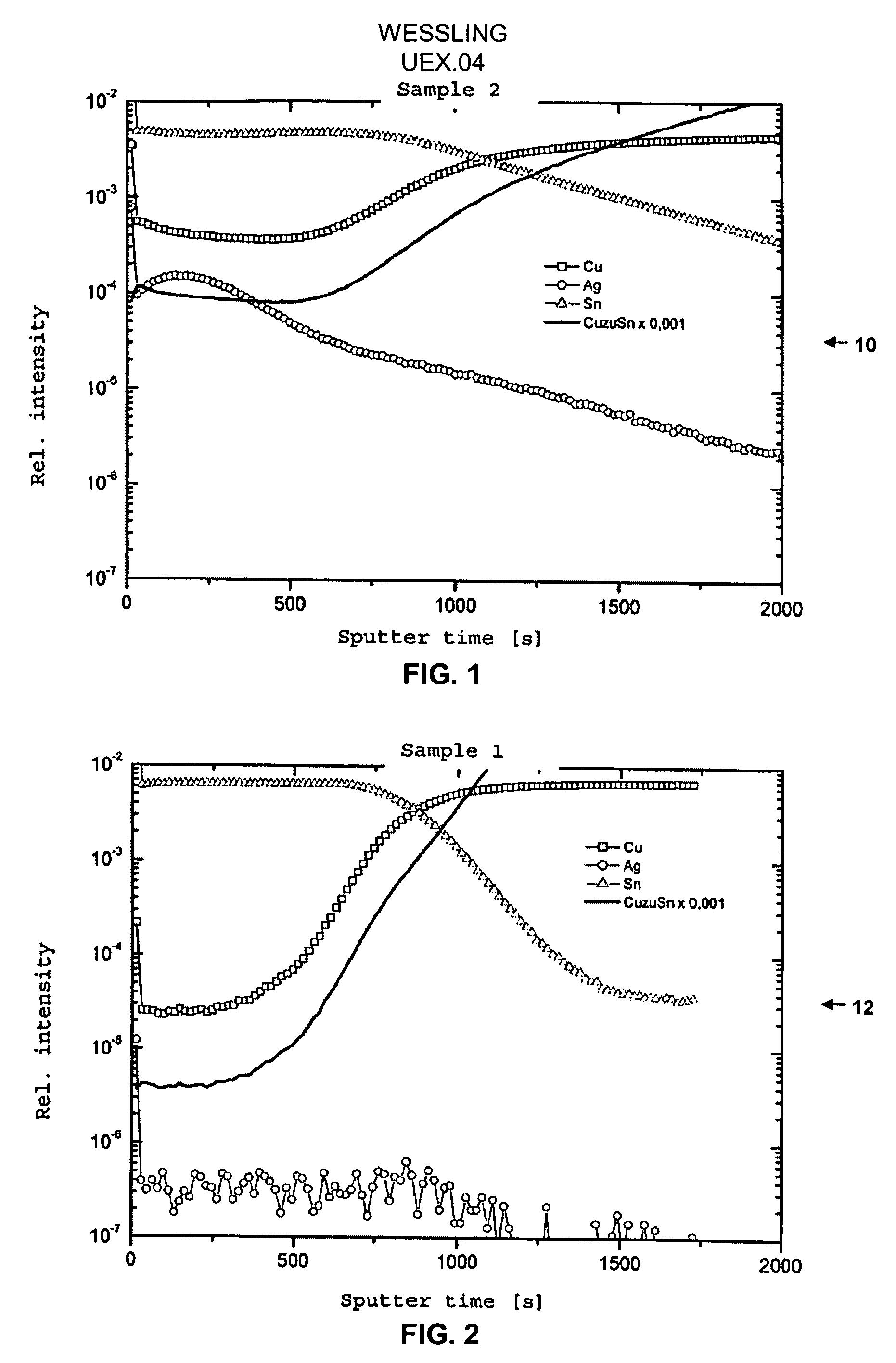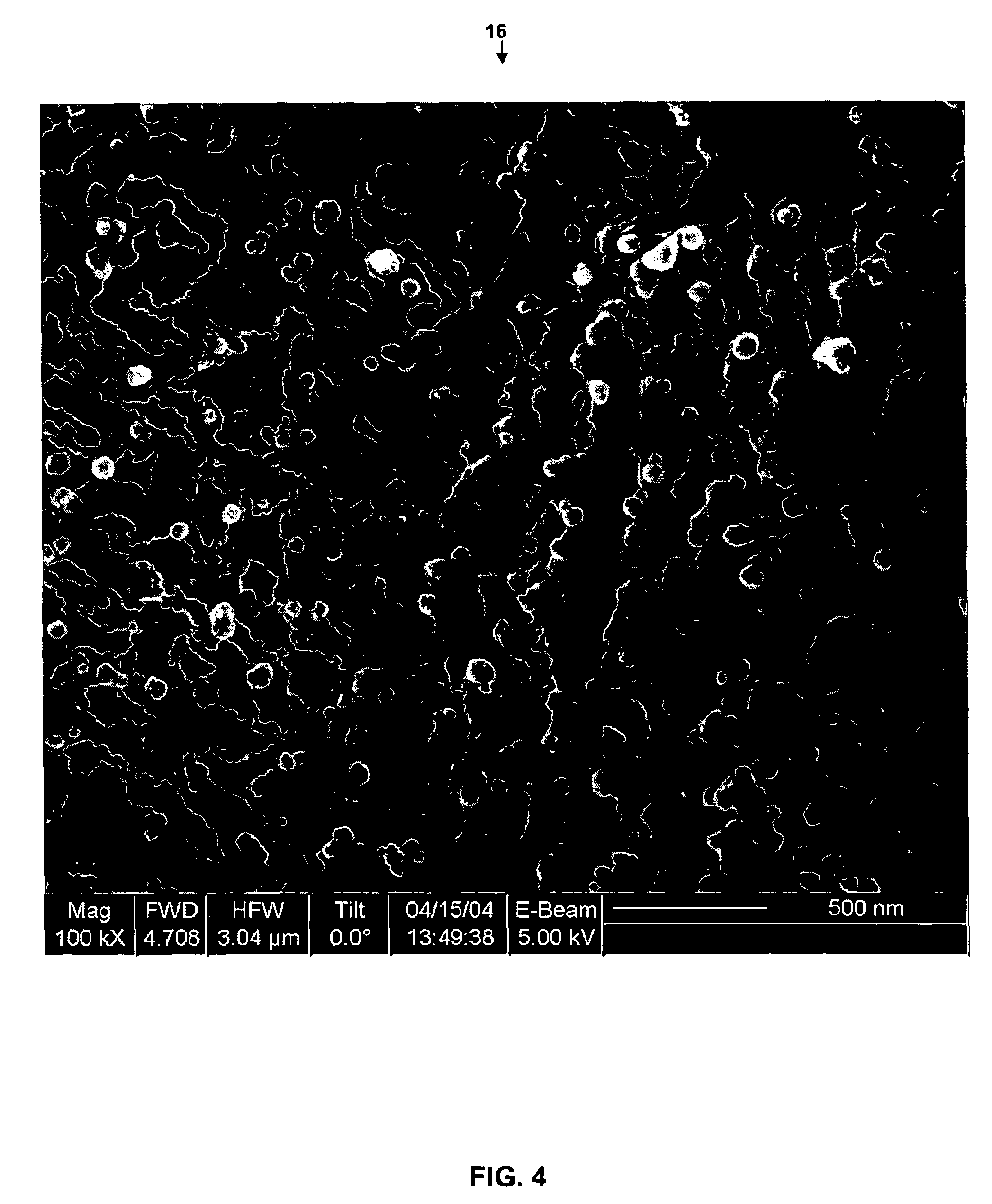Tin-coated printed circuit boards with low tendency to whisker formation
a printed circuit board and whisker technology, applied in the field of coated articles, can solve the problems of high process cost, high cost of gold coating, and inability to store for longer than 3 to 6 months
- Summary
- Abstract
- Description
- Claims
- Application Information
AI Technical Summary
Benefits of technology
Problems solved by technology
Method used
Image
Examples
embodiments
Example 1
Production of Coated Printed Circuit Boards
[0077]Epoxy resin composite printed circuit boards were cleaned and degreased using a normal commercial cleaner based on sulphuric acid and citric acid (ACL 7001, Ormecon GmbH) in a cleaning bath for 2 minutes at 45° C. The printed circuit boards used had a test design which has been agreed with test institutes and printed circuit board manufacturers and is modelled on real printed circuit board structures. These boards enable the solderability to be measured and assessed. Next, the printed circuit boards were rinsed with tap-water at room temperature and then treated with an H2O2-containing etching solution (Etch 7000, Ormecon GmbH) for 2 minutes at 30° C. After etching, the boards were again rinsed with tap-water at room temperature. After the rinsing, the printed circuit boards were immersed for 45 secs in a warm aqueous solution or dispersion at 40° C., which contained thiourea (30 g / l), sulphuric acid (20 g / l), 200 mg / l silver...
examples 2 to 7
Production of Coated Printed Circuit Boards (Comparison)
[0084]Analogously to Example 1, printed circuit boards were tinned with normal commercial agents in accordance with the respective use instructions. The products ORMECON CSN (Ormecon GmbH, Ammersbek, Example 2), ORMECON CSN FF (Ormecon GmbH, Ammersbek, Example 3), Shipley Tinposit LT 34 (Example 4), Unicron G 2 (Unicron GmbH, Kirchheimbolanden; Example 5), OMIKRON (Cirtech Co., Florida, USA; Example 6) and Stannatech (Atotech Co., Berlin; Example 7) were used.
[0085]FIG. 2 shows the secondary ion mass spectrum 12 of the printed circuit board from Comparison Example 3. From a comparison with FIG. 1 it can clearly be seen that the tin and copper concentrations display discontinuous profiles, i.e. the tin layer abruptly decreases at a sputter time of about 900 secs, while the copper concentration abruptly rises at the same time. This indicates a substantial separation of the layers. The copper to tin ratio of 10−4 is already reache...
example 8
Determination of Whisker Size
[0086]The printed circuit boards produced in Examples 1 to 7 were stored for 7 and 14 weeks at room temperature. Next, the plates were examined for the formation of whiskers by optical microscopy and if relevant the size of the whiskers was determined. For this, drill holes of 1 mm diameter were viewed, since whiskers were easier to detect here on account of the dark background. The results are shown below in Table 1.
[0087]
TABLE 1Determination of Whisker SizeStorage Time 7 WksStorage Time 14 WksExampleWhisker SizeWhisker Size1 no whiskersno whiskers2*10-20 μm—1)3*20-30 μm—1)4*>100 μm—1)5*>100 μm—1)6*20-30 μm—1)7*20-30 μm—1)*Comparison Example1)Not Measured
[0088]FIG. 6 shows an optical micrograph 20 of a printed circuit board from Example 1 after storage for 14 weeks. No whisker formation can be discerned.
[0089]FIG. 7 shows an optical micrograph 22 of the printed circuit board from Comparison Example 3 after storage for 7 weeks. The picture is focussed on...
PUM
| Property | Measurement | Unit |
|---|---|---|
| size | aaaaa | aaaaa |
| thickness | aaaaa | aaaaa |
| thickness | aaaaa | aaaaa |
Abstract
Description
Claims
Application Information
 Login to View More
Login to View More - R&D
- Intellectual Property
- Life Sciences
- Materials
- Tech Scout
- Unparalleled Data Quality
- Higher Quality Content
- 60% Fewer Hallucinations
Browse by: Latest US Patents, China's latest patents, Technical Efficacy Thesaurus, Application Domain, Technology Topic, Popular Technical Reports.
© 2025 PatSnap. All rights reserved.Legal|Privacy policy|Modern Slavery Act Transparency Statement|Sitemap|About US| Contact US: help@patsnap.com



